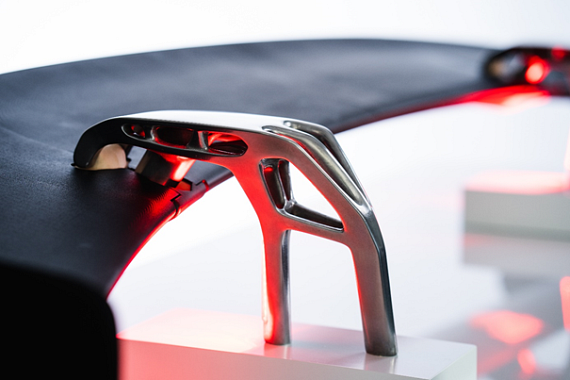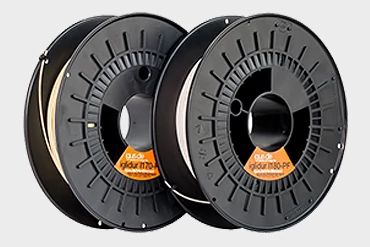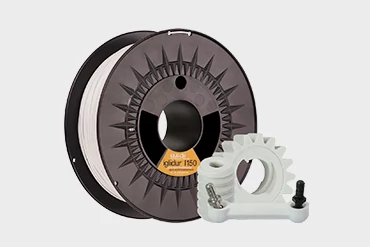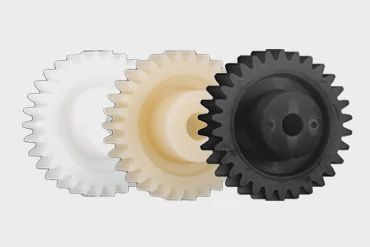Multi-objective optimisation with 3D printing
Active aerodynamics, functional integration and an attractive design
- What was needed: An active rear spoiler system
- Manufacturing method: Selective laser sintering with laser sintering powder
- Requirements: Complex component, low coefficients of friction, low weight, reduced design time and costs
- Material: iglidur I3
- Industry: Automotive
- Success through collaboration: Great time savings, reduced costs, highly complex component structure can be produced in one piece
The "WING3D" concept from the OptiAMix research project is a rear spoiler system that uses 3D printing to achieve active aerodynamics. One of the problems with rear spoilers manufactured with conventional methods is that there was no way of integrating hydraulics into the mount. The interplay of various materials, such as aluminium and tribologically optimised iglidur plastic, provides the system with an innovative functionality for adjusting the spoiler while increasing abrasion resistance.
Contact an expert

3D printing options
3D printing materials

Visit the shop
3D printing at igus®

3D printed gears

Problem verses solution
Problem
The EDAG Group's OptiAMix research project with igus GmbH was aimed at building an adjustable rear spoiler that changes position based on the car's situational driving dynamics. Active spoiler adjustment requires wear-resistant components with a low coefficient of friction. A robust material was needed so that there would still be enough room for integrated hydraulics. With the conventional manufacturing processes, the implementation of the highly complex lightweight components required for this was hardly feasible, as the planning and production of these components are too time-consuming and costly.Solution
But 3D printing allows each part to be designed and printed so that it is both fully functional and visually attractive. At the same time, a wide variety of materials can be used, allowing customised lightweight component printing. By using plain bearings printed in 3D from iglidur I3, a tribologically optimised igus polymer, the rear wing system can be operated with significantly less friction and maintenance than with normal plastic. The high-performance polymer has up to 30 times the abrasion resistance of conventional laser sintering materials and is the perfect material for adjusting the spoiler. In contrast to production methods such as milling or injection moulding, it was possible to realise the complex interior of the part via 3D printing easily and quickly - in one piece.Maintenance-free thanks to 3D printed plain bearing inserts
3D printed plain bearings were used for the rear spoiler system. The great advantage of the procedure is fast printing of the highly complex components, which would not have been feasible as easily with conventional manufacturing processes. The special shape and the complicated interior can be produced in just one piece with additive manufacturing. This reduces costs and makes production efficient. Especially in the active spoiler system, it is important that low-friction adjustment be possible. At igus GmbH, based in Cologne, 3D printing is used to transform the polymer iglidur I3, developed specifically for printing, into plain bearings that are wear-resistant while remaining low-friction. The self-lubricating parts are also maintenance-free and ideal for active rear-wing adjustment.High design requirements with full functionality
A bionic aluminium mount was manufactured for the spoiler and its integrated hydraulics. The latter achieves up to 90 bar of oil pressure from piston movement, allowing stepless angle adjustment from 6° to 42°. An electric cable for the position and angle-detection sensor is installed in the mount, enabling the spoiler to actively adjust to the driving situation. A braking function is also provided for, complemented by an LED brake light in the mount. 3D printed plain bearings were also used to reduce friction. All components for which additive manufacturing was used are adapted precisely to the other components without compromising function or aesthetics – a fantastic interplay of form and function that moves 3D printing to a new level of design.
Active system without sacrifices thanks to iglidur I3
iglidur I3 was developed specifically for laser sintering, and its abrasion resistance is up to 30 times that of conventional laser sintering materials. Solid lubricants integrated into the polymer optimise the parts' sliding properties, ensuring an especially long service life in a range of application areas. iglidur I3 gives the active system the perfect high-performance polymer it needs to combine form and function. The self-lubricating parts from the additive process ensure low-friction, maintenance-free adjustment at the spoiler's bearing points. This delivers system durability that would be impossible at this point with other plastics.Go to 3D printing service
Other application examples for 3D printed components can be found here:
All customer applications at a glance